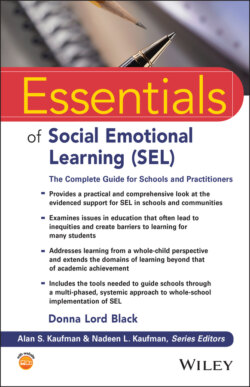Читать книгу Essentials of Social Emotional Learning (SEL) - Donna Lord Black - Страница 16
CAUTION BOX
ОглавлениеPoor program outcomes may not be the fault of the program, but may be due to other factors, such as fidelity of implementation or skill of the staff implementing the program. While there may be correlations between certain factors impacting the program’s outcomes, this does not mean these factors caused the outcomes.
It is important to point out, however, that the vast majority of SEL programs and curricula available to schools are of excellent design and may even be considered evidence‐based practices. Unfortunately, schools may not have methods or standards developed by which these products can be objectively evaluated, especially with regard to how the product aligns with the school’s specific needs. As a result, schools may make purchasing decisions based only on effectiveness claims touted by the products’ developers. Without established criteria to guide the selection process, schools are vulnerable to these attractive claims and may expend valuable resources without thoroughly reviewing whether the product complements and supports their existing efforts or if it duplicates (in whole or in part) those efforts. Questions—about how the product was developed, whether the developer applied scientific methods and principles in its development, and if field testing included a broad and diverse group of students—often go unanswered.
If this weren’t challenging enough for schools, they also must face other obstacles to implementation, such as gaining buy‐in and support from administration or staff who may not understand the full benefits of SEL. Many educators believe that adding SEL to a teacher’s plate of responsibilities is more than should be expected, given the numerous demands and accountability measures already required of them. What they struggle to recognize is that SEL is not another “add‐on” program. Rather, it is a systemic process that can ultimately strengthen the teachers’ plates.
SEL is not and never has been touted as a program that takes away from or supplants academic instruction. On the contrary, it has always been promoted as a process for enhancing instruction and improving the learning environment, and when implemented with fidelity, it contributes to improved outcomes for students and for the systems that serve them. Until educators recognize and accept that the benefits of SEL far outweigh the challenges of implementation, there will continue to be resistance.
There also may be obstacles to acquiring funding and resources, as well as to developing a SEL curriculum. Perhaps one of the most critical and often less recognized obstacles, however, is the need for staff training in SEL. Staff knowledge and skills in SEL are fundamental to a sustainable approach to implementation, but these are areas that are frequently overlooked. What are the knowledge and skills needed by staff? While there are a multitude of frameworks identifying critical social and emotional skills, the framework developed by the Collaborative for Academic, Social, and Emotional Learning (CASEL 2017) is the framework most widely adopted by schools. The competencies identified by CASEL address five key areas: self‐awareness, self‐management, social awareness, relationship skills, and responsible decision making. A graphic illustration of the framework and a detailed description of the competencies are provided in Rapid Reference 1.1.
